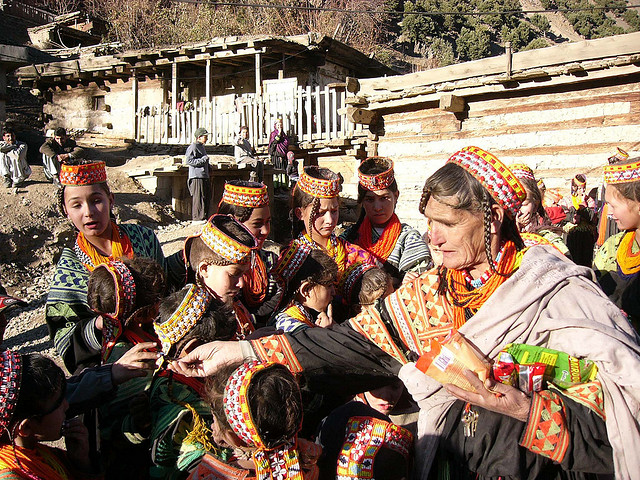KALASHA – THE WHITE TRIBE OF PAKISTAN
·
·
The Kalasha are indigenous people residing in the Chitral District of Pakistan. They speak the Kalasha language, from the Dardic family of the Indo-Iranian languages, and are considered a unique tribe among the Indo-Aryan peoples of Pakistan.
They are related to the Nuristani people of the adjacent Nuristan (historically known as Kafiristan) province of Afghanistan. An autochthonous and polytheistic by the late 19th century much of Nuristan had converted to Islam, while the Kalasha of Chitral maintain their own separate cultural traditions.
The culture of Kalash people is unique and differs completely from the various ethnic groups surrounding them. They are polytheists and nature plays a highly significant and spiritual role in their daily life.
As part of their religious tradition, sacrifices are offered and festivals held to give thanks for the abundant resources of their three valleys. Kalasha Desh (the three Kalash valleys) is made up of two distinct cultural areas, the valleys of Rumbur and Brumbret forming one and Birir valley the other, Birir valley being the most traditional of the two.
Kalash mythology and folklore has been compared to that of ancient Greece, but they are much closer to Indo-Iranian (Vedic and pre-Zoroastrian) traditions. Some of the Kalash people in their own traditions claim to be descendants of Alexander the Great’s soldiers, however, extensive genetic testing has shown no connection.
The Kalash’s origins have fascinated anthropologists due to the unusually high frequency of light hair, skin, and eyes (particularly green). Some Pashtuns and Persians too have been known to have blond hair or green eyes (such as Sharbat Gula).
In the mountains of the Hindu Kush in Pakistan, six thousand or so people live who look and sound very different from their neighbors. They claim to have lived in the area for thousands of years and they look to all intents and purposes, European.
Image Credit Flickr User Manalahmadkhan
Image Credit Flicks User Saad Sarfraz Sheikh
Many of the Kalash are blond haired and blue eyed, somewhat of an
anomaly in Pakistan! Some believe that they are descendants of
Alexander the Great’s army though their true ethnic origins are still unproven.
They have a significantly different outlook on life from the Muslims
surrounding them – they are polytheistic and have a completely different folklore
(which has been compared to that of ancient Greece).
DNA testing has not, however, produced any connection to Greek people.
Yet although there is no genetic support for a Greek origin, the tests
on the Kalash also showed no detectable East or South Asian lineages.
Taking in to account genetic drift it was then thought that the Kalash
blood line originated in Eastern Europe, the Middle East and
the Caucasus. However, another series of tests suggested that
perhaps the Kalash are in fact aboriginal to the area with only
negligible contributions from external peoples. In other words,
the jury is still out as to where they actually come from but it
might well be exactly where they are right now.
Hiten Raja
They live in Kalasha Desh – which translates as the three valleys
of the Kalash – and that is the limit of their people’s range. There are
only around five thousand speakers of the language, Kalasha, left which
in terms of a language means that it is critically endangered. However,
it is thought that the language probably never had more than a few tens
of thousands of speakers at any one time.
As their numbers are very small, the culture of the people who
surround them have had an impact. Many of the Kalash in two
of the valleys have converted to Islam, probably around fifty percent.
They still practice many of the traditional aspects of Kalash life
though the non-converts call them ‘sheiks’. A third valley,
known as Birir, still clings to the traditional way of Kalash life.
Image Credit Flickr User Manalahmadkhan

By some standards, the Kalash are very poor and it is true that they are subsistence farmers. Kalash houses are typically made from Deodar trunk to an ancient design. They appear singly or stacked up against each other up vertiginous hillsides.

























No comments:
Post a Comment